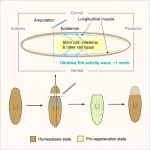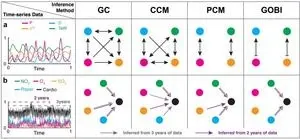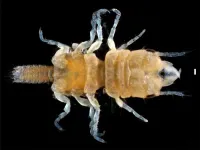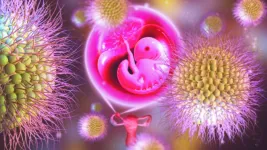(Press-News.org) A mouse injured on one leg experiences an “awakening” of stem cells in the other leg as if the cells are preparing to heal an injury. Something similar happens in axolotls, which are masters at limb regeneration. Heart injuries in zebrafish can trigger certain changes in far-away organs like the kidney and brain.
“In many different organisms, you can see the whole body respond to an injury. But whether or not those responses actually have any function has been unclear,” says Bo Wang, assistant professor of bioengineering at Stanford, “So that’s what we’re focusing on.”
In a new paper published in the journal Cell, Wang and his colleagues have found that this whole-body coordination is a crucial part of wound healing and subsequent tissue regeneration in planarian worms. Understanding what turns regeneration on and off, and how it’s coordinated, also informs studies of cancer, which is often thought of as wounds that never heal.
Worm waves
Planarians are half-inch-long flatworms with a superpower: they can regrow in almost any scenario. Cut a planarian into four pieces, and a few days later you’ve got four new flatworms. Like mice, zebrafish, and axolotls, wounds in one part of a planarian’s body seem to trigger responses in more distant tissues.
Wang wanted to understand how these responses were coordinated. One possible mechanism is the extracellular signal-related kinase (ERK) pathway. Cells use the ERK pathway to communicate with each other, and send signals out in a sort of wave. If tissue is injured, the nearest cells “pass on” that information to their neighboring cells, which then tell their neighbors. This wave propagates throughout the organism in a kind of telephone game.
There’s just one problem: past research has shown that ERK waves move too slowly to be of any use. “If I propagate a signal at 10 microns per hour, it can take days to go through one millimeter,” Wang says. At that speed, it is far too slow for a signal to get from one area of the worm to another in order to aid in wound healing and regeneration.
That may not be an issue in humans. Our circulatory system may let signals spread quickly throughout our body. But planarians don’t have a circulatory system to speed up the process.
So Wang and his colleagues began tracking the ERK waves as they traveled from one end of the animal to another. They found signals traveling over 100 times faster than previously seen. Instead of traveling in small steps from cell to cell, the ERK waves traveled along extra-long body-wall muscle cells. These cells which acted as “superhighways,” accelerate the signal from one end of the body to another. Instead of days, it took hours.
The signal was fast enough to aid in healing, but they still didn’t know if the whole body was involved.
To find out, Yuhang Fan, a graduate student in the Wang lab, cut off a planarian’s head.
Voting to grow
Normally, the planarian head quickly regrows from the remaining body after decapitation. But Fan blocked the ERK signal from spreading to the back half of the organism to test whether ERK waves were responsible for coordinating the distanced healing response.
When the ERK signals were blocked, the head didn’t just heal slower: it never regrew at all.
Next, Fan wanted to know if it was possible to “rescue” the regeneration process, and tested this by removing the planarian’s tail, too, which alerts the tail tissue that there is an injury. The tail regrew, and, astonishingly, the head grew back as well.
“What’s really interesting is that we can tune the time delay between the two amputations,” says Wang. If you cut off a planarian’s tail just a few hours after the initial injury, you can restart the blocked healing process. But if you wait too long, neither regrows.
“This implies there’s kind of a global body voting system that says, ‘Okay, now we should grow something,’ and everybody has to agree,” says Wang. And even the cells furthest away get a vote.
Healing for humans
Many animals – like planarians, sea stars, and axolotls – exhibit healing and regenerative ability far beyond that of humans. Understanding why we lack such abilities could lead to advances in medical treatments and interventions, including implications related to cancer.
“You don’t want tissues in a wounded state all the time. That may cause cancer,” explains Wang. Even in these spectacularly regenerative worms, Wang’s research reveals that most of the time, regeneration is turned “off,” until the whole body agrees that it’s time to turn “on.”
Additionally, as Wang and his colleagues tracked ERK waves spreading throughout planarians’ bodies, they noted that hundreds of genes were turned on and off. Although humans are only very distantly related to planarians, we share many of those same genes.
“This really gives us an entryway to go after those genes,” says Wang. “It could allow us to figure out how animals regenerate while managing the risk of uncontrolled cancerous growth.”
Additional Stanford co-authors include graduate students Yuhang Fan (lead author), Chew Chai, and Xinzhi Zou; Pengyang Li, PhD ’22; and James Ferrell, professor of chemical and systems biology and of biochemistry in the School of Medicine. Farrell is also a member of Stanford Bio-X, the Stanford Cancer Institute, and the Wu Tsai Neurosciences Institute. Wang is also a member of Stanford Bio-X and the Wu Tsai Neurosciences Institute.
This research was funded by Stanford Bio-X PhD Fellowship Program, the National Science Foundation, a Stanford Graduate Fellowship, the Beckman Young Investigator Program, and the National Institutes of Health
END
Regeneration might be a whole-body affair
In certain organisms, injuries on one part of the body can induce a healing response in another. New evidence suggests this whole-body response isn’t a side effect: it’s the main feature.
2023-07-25
ELSE PRESS RELEASES FROM THIS DATE:
Mesoamerica a model for modern metropolises
2023-07-25
Jakarta … San Francisco … Shanghai … Phoenix … Houston.
These major cities and others around the globe have many similarities, but they share one particular commonality that is concerning for residents. They are among the global cities most affected by climate change.
While each of these cities has proven resilient for centuries, urban planners, community leaders and civil engineers continue to address their many environmental challenges. In preparing for these cities’ future, however, it might be more ...
What can central Utah’s earthquake ‘swarms’ reveal about the West’s seismicity?
2023-07-25
Most of the earthquakes rumbling under the West’s Great Basin come in surges, clustered together in time and place. Scientists call these seismic groups “swarms,” which are a distinct category from the numerous aftershocks following a big shake, such as the 5.7 magnitude Magna quake of 2020 on the Wasatch Fault.
Rather than getting spread out evenly over time, many of these small, often imperceptible quakes strike a region in a short period of time, say a few days or weeks.
Central Utah has been the stage for dozens of earthquake swarms that have been recorded over the past 40 years by an ever-expanding network of seismic arrays managed by the University ...
Encouraging Latinx youth to embrace ethnic pride can enhance their well-being
2023-07-25
Encouraging Latinx adolescents of Mexican origin to embrace their ethnic pride, cultural values, and connections to their cultural community contributes to positive development and better adjustment during adolescence, a new University of California, Davis, psychology study suggests.
Moreover, researchers said, cultural preservation can help Latinx youth cope with adverse life experiences and social threats such as racism and discrimination.
The study results were published this month in ...
Chapman University climate scientist finds new way to measure the Earth’s ability to offset carbon emissions
2023-07-25
A Chapman University scientist and his colleagues have determined how the Earth responds as it heats up due to climate change.
The scientists say a warming world calls for a new approach in detecting how much carbon dioxide comes out of ecosystems when the temperature changes — which tells us how well plants and soil can alleviate damage by removing carbon pollution from the atmosphere. The study is the first to find the temperature-carbon dioxide release relationship at the landscape level.
Their ...
Scientists discover new isopod species in the Florida Keys
2023-07-25
An international team of scientists from the University of Miami Rosenstiel School of Marine, Atmospheric, and Earth Science and the Water Research Group from the Unit for Environmental Sciences and Management at the North-West University in South Africa have discovered a new species of marine cryptofauna in the Florida Keys. Cryptofauna are the tiny, hidden, organisms that make up the majority of biodiversity in the ocean.
The roughly three-millimeter-long isopod is one of only 15 species from the genus Gnathia currently known in the region.
The newly discovered species, Gnathia jimmybuffetti, which is a member of a group of crustaceans called gnathiid isopods, were collected ...
New drug delivery system shows promise in treatment of life-threatening pregnancy condition
2023-07-25
PORTLAND, Ore. – Researchers in the Oregon State University College of Pharmacy have developed a drug delivery system that shows promise for greatly enhancing the efficacy of the medicine given to women with the life-threatening condition of ectopic pregnancy, which occurs when a fertilized egg implants somewhere other than the lining of the uterus.
Olena Taratula of the OSU College of Pharmacy, and Maureen Baldwin and Leslie Myatt of Oregon Health & Science University led a team that used a mouse model to show ...
Experts call for independent inquiry into Canada’s COVID-19 response
2023-07-25
At first glance, Canada appears to have responded adequately to the covid-19 emergency, but beneath the surface lie major pandemic failures, warns a series of articles published by The BMJ today.
The BMJ Canada Covid Series provides a critical analysis of what worked and what didn’t in Canada’s covid-19 response and calls for a national independent review to learn lessons and ensure accountability for the past and future preparedness.
The articles, written by leading clinicians and researchers representing 13 institutions across Canada, highlight long-standing weaknesses ...
Bisexual people experience worse health outcomes than other adults in England – national study of more than 835,000 people
2023-07-25
Self-reported data from lesbian, gay or bisexual (LGB) patients shows these groups have poorer health outcomes compared to those who identify as heterosexual, but bisexual people disproportionally experience the worst outcomes in England.
These new findings, published today in the peer-reviewed journal The Journal of Sex Research, indicate that bisexual people face additional health disparities within an already marginalised community.
Experts, from the Brighton and Sussex Medical School and Anglia Ruskin University who led the analysis of more than 835,000 adults in England, suggests the disparities could result from unique prejudice and discrimination ...
Family loses child to necrotizing enterocolitis and publishes “Forever Our Little One,” a storybook for bereaved families
2023-07-25
Davis, CA – Mother-daughter duo Jennifer Canvasser and Leslie Napolitano have published Forever Our Little One, a storybook for bereaved families. Jennifer is the executive director of the Necrotizing Enterocolitis (NEC) Society, which she founded after her son Micah tragically died from complications of NEC. Leslie is an artist and illustrator who helped care for her grandson Micah during his time in the neonatal and pediatric intensive care units. Jennifer wrote the storybook for families ...
Curbing waste improves global food security but has limited environmental benefits
2023-07-24
Irvine, Calif., July 24, 2023 – Reducing waste is one way to help combat hunger around the world, but stricter control over food loss and waste does not lead to better environmental outcomes, according to researchers at the University of California, Irvine and the University of Colorado Boulder.
In a paper published recently in Nature Food, the scientists stress that curbing food spoilage increases the amount of produce in markets, which leads to lower costs. Cheaper food encourages people to buy and eat more, offsetting the lowering of greenhouse gas ...
LAST 30 PRESS RELEASES:
Strengthened immune defense against cancer
Engineering the development of the pancreas
The Journal of Nuclear Medicine ahead-of-print tip sheet: Jan. 9, 2026
Mount Sinai researchers help create largest immune cell atlas of bone marrow in multiple myeloma patients
Why it is so hard to get started on an unpleasant task: Scientists identify a “motivation brake”
Body composition changes after bariatric surgery or treatment with GLP-1 receptor agonists
Targeted regulation of abortion providers laws and pregnancies conceived through fertility treatment
Press registration is now open for the 2026 ACMG Annual Clinical Genetics Meeting
Understanding sex-based differences and the role of bone morphogenetic protein signaling in Alzheimer’s disease
Breakthrough in thin-film electrolytes pushes solid oxide fuel cells forward
Clues from the past reveal the West Antarctic Ice Sheet’s vulnerability to warming
Collaborative study uncovers unknown causes of blindness
Inflammatory immune cells predict survival, relapse in multiple myeloma
New test shows which antibiotics actually work
Most Alzheimer’s cases linked to variants in a single gene
Finding the genome's blind spot
The secret room a giant virus creates inside its host amoeba
World’s vast plant knowledge not being fully exploited to tackle biodiversity and climate challenges, warn researchers
New study explains the link between long-term diabetes and vascular damage
Ocean temperatures reached another record high in 2025
Dynamically reconfigurable topological routing in nonlinear photonic systems
Crystallographic engineering enables fast low‑temperature ion transport of TiNb2O7 for cold‑region lithium‑ion batteries
Ultrafast sulfur redox dynamics enabled by a PPy@N‑TiO2 Z‑scheme heterojunction photoelectrode for photo‑assisted lithium–sulfur batteries
Optimized biochar use could cut China’s cropland nitrous oxide emissions by up to half
Neural progesterone receptors link ovulation and sexual receptivity in medaka
A new Japanese study investigates how tariff policies influence long-run economic growth
Mental trauma succeeds 1 in 7 dog related injuries, claims data suggest
Breastfeeding may lower mums’ later life depression/anxiety risks for up to 10 years after pregnancy
Study finds more than a quarter of adults worldwide could benefit from GLP-1 medications for weight loss
Hobbies don’t just improve personal lives, they can boost workplace creativity too
[Press-News.org] Regeneration might be a whole-body affairIn certain organisms, injuries on one part of the body can induce a healing response in another. New evidence suggests this whole-body response isn’t a side effect: it’s the main feature.




